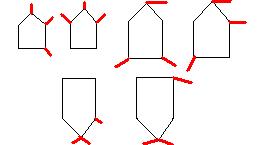FOR MONOCHLORO DERIVATIVES I GOT 5 AS ANSWER
Let f(x) =[ (2x3 - 9x2 + 12x + 3) (x- a) ] / (x-a)
If range of f(x) is a proper subset of real no.s , then the most exhaustive set in which a lies is
(A) (-∞,7) U (8,∞)
(B) (-∞,7] U [8,∞)
(C) (-∞,1/2] U [5/2,∞)
(D) (-∞,1/2) U (5/2 , ∞]
-
UP 0 DOWN 0 0 21

21 Answers
for the 1st one, the important thing is that we want the function to take all values on R, so alpha should be a value which the function takes twice..
That range will be a superset of [1,2] (this comes from the derivative of the function (cubic) given)
Now figure this out soumik
and i dont think this question was wrong.. infact a very good questoni :)
@ E= MC^2
in Qn. 5
try to name the compounds u have drawn...u will come to know that where u have done the mistake ..btw the answer is four
FOR #2
I got (A) & (B) But (D) is not always true
Eg : l - 2x2 + 2x + 1 l ≤ l - 3x2 + 3x + 1 l
@Arshad I solved the same way and got the points as 1,2
Now I have a doubt b/w C & D
for the first question just differentiate
2x3 - 9x2 + 12x + 3
and
u will get two points.....those two pints and and all points between them will be the domain of 2x3 - 9x2 + 12x + 3.....
and as a cannot be eual to x....therefore all points the domain of the above func...will be the values of a....simple enuff i think.....
l ax2 + bx + c l ≤ l Ax2 + Bx + C l for all x ε R & d = b2 - 4ac > 0 ,
D - B2 - 4AC > 0 also aA ≠0 then
(A) l a l ≤ l A l
(B) l d l ≤ l D l
(C) l a l l d l = l A ll D l
(D) l a l2 l D l = l A l2 l d l
I got (A) & (B) But (D) is not always true
Eg : l - 2x2 + 2x + 1 l ≤ l - 3x2 + 3x + 1 l
no...actually mr E=MC2 got the question(or its nomenclature) wrong,,,it was actually cyclopentane !
3) Nitrogen (-3 ---> 0) ; Chromium (+6 -----> +3)
Net n-factor =2* 3 +2*(3) = 12
4) Waise, 2nd order kinetics is not in course officially....
But regarding it 2b a simple case, -dA/dt = K[A]2
This gives → Kt = 1/A - 1/A0
Fr t 50%, A =A0/2 & fr t 75% ,A = A0/4,
Substitute n divide, v get x=3.
5) If the compound is n-pentane, Only 3 monochlorinated products are possible.
solve the 1st qsn, some answers given ( as usual) in fiitjee are wrong btw...
ans for the second order q
for second order rcn
1/At - 1/Ao = Kt
simplly put At as A0 /4 and in the next case as A0 /2
youll get ans as 3
dont know what the bullshit they have done in the solution
Plz post u're solns & not alone the ans as i have all the answers & have put these qs due to
some small doubts in the given key
If a tangent of slope 2 of the ellipse x^2/a^2 + y^2/b^2 = 1 is normal to the circle
x^2+y^2+4x +1 = 0 then the max value of ab = ?
Find the total no of monochloroderivatives of the given compd (excluding stereoisomers)
CYCLOPENTANE
CHEMISTRY
Δ
(NH4)2Cr2O7 ----> N2 + Cr2O3 + 4H2O
What will be the n-factor in the abv reacn?
(This is an easy qs but i had prob with ans)
ANSWERED
